#akhetaten
Text
Egyptian ring featuring 'god of fun' discovered in ancient burial

Archaeologists in Egypt have unearthed stunning gold jewelry, including a ring depicting the "god of fun," in a burial that's more than 3,300 years old, the Egyptian Ministry of Tourism and Antiquities announced.
The burial is located in the northern part of the ancient city of Akhetaten (modern-day Amarna), about 186 miles (300 kilometers) south of Cairo. This city was built by the pharaoh Akhenaten (reign circa 1353 B.C. to 1336 B.C.), who tried to change Egypt's polytheistic religion by focusing it around the worship of the Aten, the sun disk. He moved Egypt's capital city from Thebes in modern-day Luxor to the newly built desert city of Akhetaten. Ultimately Akhenaten's religious reforms were undone by his son, Tutankhamun, and the new city was abandoned not long after Akhenaten's death. Read more.
341 notes
·
View notes
Text
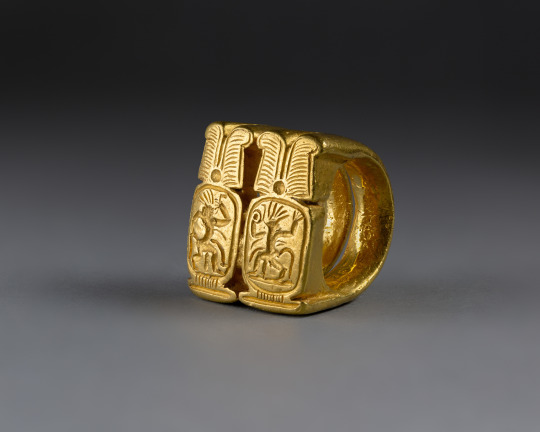
Signet Ring - Met Museum Collection
Inventory Number: 24.2.8
New Kingdom, Amarna Period, Dynasty 18, ca. 1353–1323 B.C.
Location Information: From Egypt; Said to be from Middle Egypt, Amarna (Akhetaten)
Description:
The ring bezel is decorated with the royal device of two cartouches topped by ostrich plumes. The cartouches frame dancing figures of Bes, a minor god who frightened away demons and killed snakes and other harmful animals. Bes was closely associated with women in labor and with small children, and use of his image on this ring suggests that it belonged to a queen.
#signet ring#ring#rings#jewelry#new kingdom#new kingdom ap#dynasty 18#middle egypt#upper egypt#amarna#akhetaten#met museum#24.2.8#NKAPJ
2 notes
·
View notes
Text

I'm having an arty day clearly.
Smenkhkare and Meritaten
#Smenkhkare#Meritaten#Amarna#pharaoh#Egypt#egyptology#art#Egypt art#Akhenaten#ancient Egypt#Akhetaten
8 notes
·
View notes
Text
Beautiful stuff. Anna Stevens is at Monash University in Melbourne, though.
2 notes
·
View notes
Text
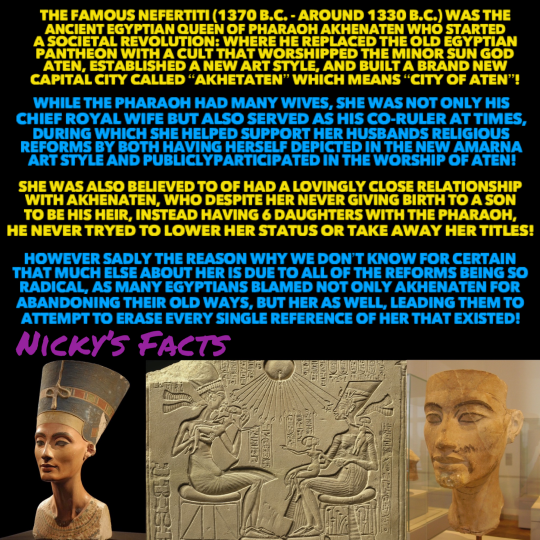
All hail Nefertiti, who turned her back on the old ways!𓆸
#history#nefertiti#ancient egypt#queen#akhenaten#womens history#akhetaten#royalty#egyptian queen#egyptology#historical figures#ancient egyptian history#amarna period#queencore#ancient#femininity#new kingdom#egypt#royal history#cult of aten#queen of egypt#kemetic#historical women#ancient history#nickys facts
1 note
·
View note
Text

Statue of Akhenaten and Nefertiti
New Kingdom, 18th Dynasty, ca. 1353-1336 BC.
From Tell el-Amarna (Akhetaten).
Now in the Louvre. E 15593
Read more
213 notes
·
View notes
Photo

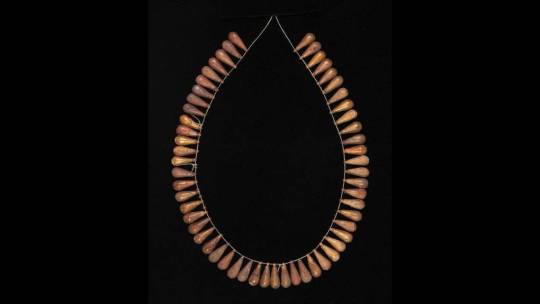





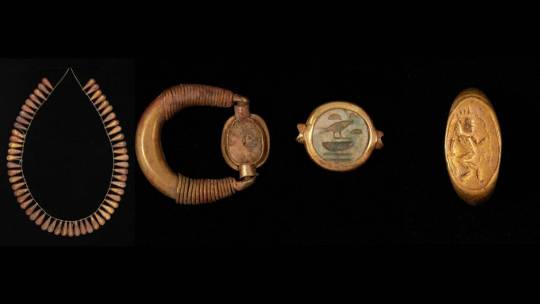

3,500-Year-Old Gold Jewelry Found in Egyptian 18th Dynasty Tomb
The jewelry collection was discovered by a team of Egyptian and English archaeologists.
A collection of ornate gold jewelry dating back to 3,500 years ago was recently discovered at the Tell El-Amarna necropolis, along the eastern bank of the Nile River in Egypt.
The necropolis, located in modern-day Minya, was a burial ground for the city of Amarna, or Akhetaten, and was constructed in 1346 BCE to serve as the capital city of the Pharaoh Akhenaten, the 10th ruler of the late Eighteenth Dynasty.
The jewelry collection was discovered by a team of Egyptian and English archaeologists who were working on excavations at the Amarna North Desert Cemetery when they unearthed the burial site of a young adult female.
The woman had been wrapped in textile and plant-fiber matting and buried wearing a necklace with petal-shaped pendants as well as three rings made from gold and soapstone.
The image of the ancient Egyptian deity Bes, who was worshipped as a protector of mothers, children and childbirth, is engraved on one of the three rings.
The other two rings are inscribed with a phrase in hieroglyphics that translates into “lady of the two lands,” presumably referring to Egypt’s lower and upper kingdoms.
The young woman was buried among a small number of other burial shafts, pit graves and tombs, all of which date back to 1550-1292 BCE, during the Eighteenth Dynasty.
Although the Akhenaten initially followed traditional Ancient Egyptian polytheistic religion, he later created his own religion, called Atenism, which centered around the worship of the sun god Aten.
Construction on the city was started around the fifth year of his reign (1346 BCE) and is thought to have been completed by the ninth (1341 BCE), although it only became the capital city two years after completion.
The city was abandoned soon after the pharoah's death when his son, King Tutankhamun decided to leave it behind in favor of his birthplace in Thebes.
As a result, the city and its internal plans were largely preserved, as once it had been abandoned it remained uninhabited until Roman settlement in the area. Today, the ruins of the city include grand temples, palaces and tombs.
According to Ahram Online, the ancient city continues to transform our understanding of how human society has developed, due to its status as one of the world's preeminent archaeological sites for understanding how people lived in the pre-Classical world.
#3500 year-old gold jewelry Found in Egyptian 18th Dynasty Tomb#Tell El-Amarna necropolis#ancient tomb#ancient grave#ancient necropolis#ancient artifacts#archeology#archeolgst#jewelry#gold jewelry#ancient jewelry#treasure#history#history news#ancient history#ancient culture#ancient civilizations#ancient egypt#egyptian history#egyptian art
141 notes
·
View notes
Photo
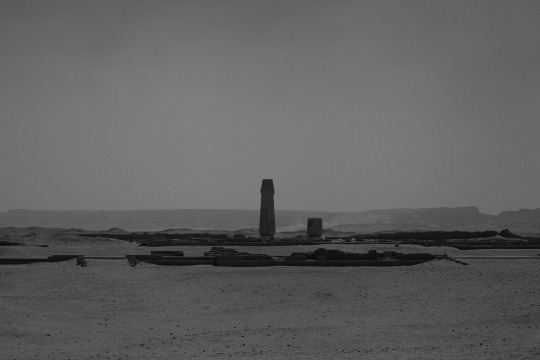


Amarna (Middle Egypt)
Archeological site where ancient city of Akhetaten ("City of the Horizon”) used to be. Established by Pharaoh Akhenaten (formerly Amenhotep IV) around 1346 BC.
#amarna#cities in dust#middle egypt#akhenaten#archeology#ancient egypt#desert#ruins#black and white photography#aten#egypt diary
49 notes
·
View notes
Text






Aten
Other names:Aton, Atonu, or Itn
Major cult center:Amarna
Symbol:Sun disk and reaching rays of light.
Domain:Sky and sun
Aten also Aton, Atonu, or Itn was the focus of Atenism, the religious system established in ancient Egypt by the Eighteenth Dynasty pharaoh Akhenaten. The Aten was the disc of the sun and originally an aspect of Ra, the sun god in traditional ancient Egyptian religion. Akhenaten, however, made it the sole focus of official worship during his reign. In his poem "Great Hymn to the Aten", Akhenaten praises Aten as the creator, giver of life, and nurturing spirit of the world. Aten does not have a creation myth or family but is mentioned in the Book of the Dead. The worship of Aten was initially dismantled by Tutankhamun and later eradicated by Tutankhamun's former military general Horemheb.
The cult-centre of Aten was at the new city Akhetaten; some other cult cities include Thebes and Heliopolis. The principles of Aten's cult were recorded on the rock walls of tombs of Amarna. Significantly different from other ancient Egyptian temples, temples of Aten were open-roofed to allow the rays of the sun. Doorways had broken lintels and raised thresholds. No statues of Aten were allowed; those were seen as idolatry.However, these were typically replaced by functionally equivalent representations of Akhenaten and his family venerating the Aten and receiving the ankh (breath of life) from him. Priests had less to do since offerings (fruits, flowers, cakes) were limited, and oracles were not needed.
Worship
In the worship of the Aten, the daily service of purification, anointment and clothing of the divine image was not performed. Incense was burnt several times a day. Hymns sung to Aten were accompanied by harp-music. Aten's ceremonies in Akhetaten involved giving offerings to Aten with a swipe of the royal scepter. Instead of barque-processions, the royal family rode in a chariot on festival days. Elite women were known to worship the Aten in sun-shade temples in Akhetaten.
Religion
The solar Aten was extensively worshipped as a god in the reign of Amenhotep III when it was depicted as a falcon-headed man much like Ra. In the reign of Amenhotep III's successor, Amenhotep IV, the Aten became the central god of the Egyptian state religion, and Amenhotep IV changed his name to Akhenaten to reflect his close link with the new supreme deity.
The principles of Aten's religion were recorded on the rock tomb walls of Akhetaten. In the religion of Aten (Atenism), night is a time to fear. Work is done best when the sun, Aten, is present. Aten cares for every creature, and created a Nile river in the sky (rain) for the Syrians.Aten created all countries and people. The rays of the sun disk only holds out life to the royal family; everyone else receives life from Akhenaten and Nefertiti in exchange for loyalty to Aten. Aten is depicted caring for the people through Akhenaten by Aten's hands extending towards the royalty, giving them ankhs representing life being given to humanity through both Aten and Akhenaten. In Akhenaten's Hymn to Aten, a love for humanity and the Earth is depicted in Aten's mannerisms:
Aten bends low, near the earth, to watch over his creation; he takes his place in the sky for the same purpose; he wearies himself in the service of the creatures; he shines for them all; he gives them sun and sends them rain. The unborn child and the baby chick are cared for; and Akhenaten asks his divine father to 'lift up' the creatures for his sake so that they might aspire to the condition of perfection of his father, Aten
Akhenaten represented himself not as a god, but as a son of Aten, shifting the previous methods of pharaohs claiming to be the embodiment of Horus. Akhenaten positioned himself as the only intermediary who could speak to Aten. This contributes to the belief that Atenism should be considered a monotheistic religion where "the living Aten beside whom there is no other; he was the sole god".
There is only one known instance of the Aten talking, "said by the 'Living Aten': my rays illuminate…"
Aten is an evolution of the idea of a sun-god in Egyptian mythology, deriving a lot of his concepts of power and representation from the earlier god Ra but building on top of the power Ra represents. Aten carried absolute power in the universe, representing the life-giving force of light to the world as well as merging with the concept and goddess Ma'at to develop further responsibilities for Aten beyond the power of light itself.
Iconography
Aten, by nature, was everywhere and intangible because he was the sunlight and energy in the world. Therefore, he did not have physical representations that other Egyptian gods had; he was represented by the sun disc and reaching rays of light. The explanation as to why Aten could not be fully represented was that Aten was beyond creation. Thus the scenes of gods carved in stone previously depicted animals and human forms, now showed Aten as an orb above with life-giving rays stretching toward the royal figure. This power transcended human or animal form.
Later, iconoclasm was enforced, and even sun disc depictions of Aten were prohibited in an edict issued by Akhenaten. In the edict, he stipulated that Aten's name was to be spelt phonetically.
──────⊰In Workings⊱──────
Ideas for honoring or working with/worshipping Aten
*Please know basic protections and energy work before attempting any deity work.*
*It is important to note that everyone's experiences are different and will work with spirits for different reasons. Some people may like a spirit while others will not and that's okay. Ask these spirits what they will work with you on as well as ask them if they can help you with whatever it is you need.*
Aten representing the sun itself. Giving life to all things and providing for nature. Appreciation for the light Aten gives.
During Amenhotep-Akhenatens reign using any form of statue was seen as idolatry. So it's entirely up to you if you find it appropriate or not to have one for Aten. It may be appropriate to do outdoor offerings since Aten is the sun itself.
Altar
Make alter outside or under a window or skylight.Burn Inscence.
⬩Altar cloth (maybe one of the sun)
⬩Chalice or cup
⬩Offering bowl
⬩Yellow or white candles (you can use any color)
⬩Incense and incense burner
⬩No statues were used but that's up to you
For more information on basic deity work and altar setups check out the deity work post.
Basic offerings:Bread, Cakes, Flowers, Frankincense, Fruits, Myrrh, Water
Rituals
Say or sing Atens hymn and play harp music. Use a wand or sceptre and wave it in front of the sun.
⬩Honoring the sun
⬩Summer solstice
Great Hymn to the Aten
Thou appearest beautifully on the horizon of heaven,
Thou living Aton, the beginning of life!
When thou art risen on the eastern horizon,
Thou hast filled every land with thy beauty.
Thou art gracious, great, glistening, and high over every land;
Thy rays encompass the lands to the limit of all that thou hast made:
As thou art Re, thou reachest to the end of them;
(Thou) subduest them (for) thy beloved son.
Though thou art far away, thy rays are on earth;
Though thou art in their faces, no one knows thy going.
When thou settest in the western horizon,
The land is in darkness, in the manner of death.
They sleep in a room, with heads wrapped up,
Nor sees one eye the other.
All their goods which are under their heads might be stolen,
(But) they would not perceive (it).
Every lion is come forth from his den;
All creeping things, they sting.
Darkness is a shroud, and the earth is in stillness,
For he who made them rests in his horizon.
At daybreak, when thou arisest on the horizon,
When thou shinest as the Aton by day,
Thou drivest away the darkness and givest thy rays.
The Two Lands are in festivity every day,
Awake and standing upon (their) feet,
For thou hast raised them up.
Washing their bodies, taking (their) clothing,
Their arms are (raised) in praise at thy appearance.
All the world, they do their work.
All beasts are content with their pasturage;
Trees and plants are flourishing.
The birds which fly from their nests,
Their wings are (stretched out) in praise to thy ka.
All beasts spring upon (their) feeet.
Whatever flies and alights,
They live when thou hast risen (for) them.
The ships are sailing north and south as well,
For every way is open at thy appearance.
The fish in the river dart before thy face;
Thy rays are in the midst of the great green sea.
Creator of seed in women,
Thou who makest fluid into man,
Who maintainest the son in the womb of his mother,
Who soothest him with that which stills his weeping,
Thou nurse (even) in the womb,
Who givest breath to sustain all that he has made!
When he descends from the womb to breathe
On the day when he is born,
Thou openest his mouth completely,
Thou suppliest his necessities.
When the chick in the egg speaks within the shell,
Thou givest him breath within it to maintain him.
When thou hast made him his fulfillment within the egg, to break it,
He comes forth from the egg to speak at his completed (time);
He walks upon his legs when he comes forth from it.
How manifold it is, what thou hast made!
They are hidden from the face (of man).
O sole god, like whom there is no other!
Thou didst create the world according to thy desire,
Whilst thou wert alone: All men, cattle, and wild beasts,
Whatever is on earth, going upon (its) feet,
And what is on high, flying with its wings.
The countries of Syria and Nubia, the land of Egypt,
Thou settest every man in his place,
Thou suppliest their necessities:
Everyone has his food, and his time of life is reckoned.
Their tongues are separate in speech,
And their natures as well;
Their skins are distinguished,
As thou distinguishest the foreign peoples.
Thou makest a Nile in the underworld,
Thou bringest forth as thou desirest
To maintain the people (of Egypt)
According as thou madest them for thyself,
The lord of all of them, wearying (himself) with them,
The lord of every land, rising for them,
The Aton of the day, great of majesty.
All distant foreign countries, thou makest their life (also),
For thou hast set a Nile in heaven,
That it may descend for them and make waves upon the mountains,
Like the great green sea,
To water their fields in their towns.
How effective they are, thy plans, O lord of eternity!
The Nile in heaven, it is for the foreign peoples
And for the beasts of every desert that go upon (their) feet;
(While the true) Nile comes from the underworld for Egypt.
Thy rays suckle every meadow.
When thou risest, they live, they grow for thee.
Thou makest the seasons in order to rear all that thou hast made,
The winter to cool them,
And the heat that they may taste thee.
Thou hast made the distant sky in order to rise therein,
In order to see all that thou dost make.
Whilst thou wert alone,
Rising in thy form as the living Aton,
Appearing, shining, withdrawing or aproaching,
Thou madest millions of forms of thyself alone.
Cities, towns, fields, road, and river --
Every eye beholds thee over against them,
For thou art the Aton of the day over the earth....
Thou are in my heart,
And there is no other that knows thee
Save thy son Nefer-kheperu-Re Wa-en-Re,
For thou hast made him well-versed in thy plans and in thy strength.
The world came into being by thy hand,
According as thou hast made them.
When thou hast risen they live,
When thou settest they die.
Thou art lifetime thy own self,
For one lives (only) through thee.
Eyes are (fixed) on beauty until thou settest.
All work is laid aside when thou settest in the west.
(But) when (thou) risest (again),
[Everything is] made to flourish for the king,
Since thou didst found the earth
And raise them up for thy son,
Who came forth from thy body: the King of Upper and Lower Egypt, Ak-en-Aton, .and the Chief Wife of the King Nefert-iti, living and youthful forever and ever.
𖤓𖤓𖤓𖤓𖤓𖤓𖤓𖤓𖤓𖤓𖤓𖤓𖤓𖤓𖤓𖤓𖤓𖤓𖤓𖤓𖤓

For more content relating to other practices/religions or pantheons follow my main blog for updates or ask me anything
If you have any more questions or wish to join a community feel free to join my 18+ discord server
#Aten#occult#Kemetism#Kemetic#Kemetic witch#Kemetic pagan#kemetic paganism#netjeru#neteru#Egyptian gods#egyptian deities#witchblr#deity#witchcraft#spirit#spirits#occultblr#kemetblr#paganblr#occultism#paganism#pagan#pagan witch
9 notes
·
View notes
Text
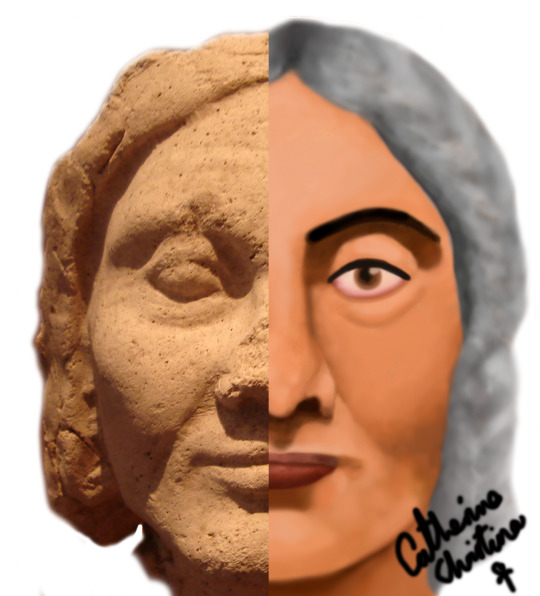
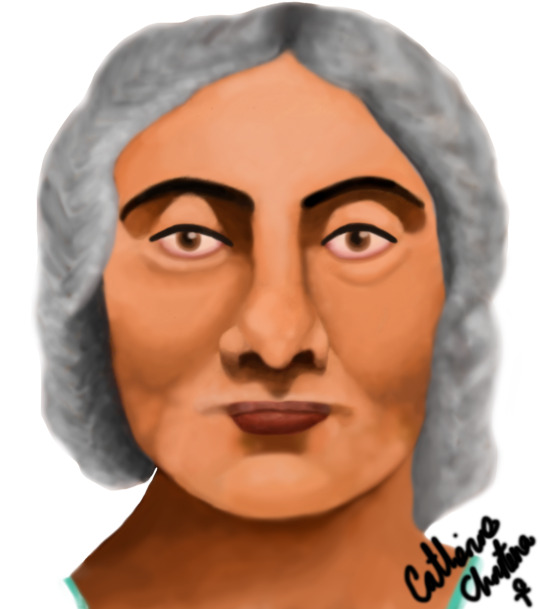
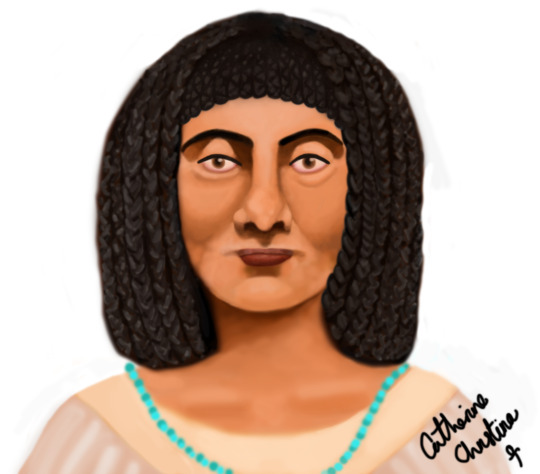
My little drawing of the plaster face of a woman from Amarna (ancient Akhetaten), found in the sculptor Thutmose's studio. I call her, "Omm Amarna" :) lol. I drew her without wig and with wig.
#ancient egypt#thutmose#sculptor thutmose#amarna period#amarna#akhenaten#nefertiti#artists on tumblr
9 notes
·
View notes
Text

Collar - British Museum Collection
Inventory Number: EA59334
New Kingdom, Amarna Period, Dynasty 18
Location Information: Minya, el- (Governorate): Amarna, el-
Description:
Glazed composition open-work broad collar: the top row represents yellow and blue mandrake fruits; the middle row is composed of green date palm leaves and the lowest of yellow, white and mauve lotus petals. Between the pendants are strung tiny disc beads in red, blue, mauve or yellow. Even the two triangular terminals into which the stringing threads pass to emerge as a single united cord at each side of the collar take the shape of a lotus inlaid in red, yellow, blue and green to indicate the individual petals. All the elements were made in open moulds, as their backs are flat and not detailed.
It is highly likely that jewellery elements depicting fruit, flowers and parts of plants had an amuletic significance, since all growing plants were inherently symbolic of new life and some flowers actually open each morning, reconfirming the idea of resurrection. This collar was found complete but the original order of stringing could not be determined.
#broad collar#broad collars#jewelry#new kingdom#new kingdom ap#dynasty 18#amarna#akhetaten#upper egypt#NKAPJ
0 notes
Text
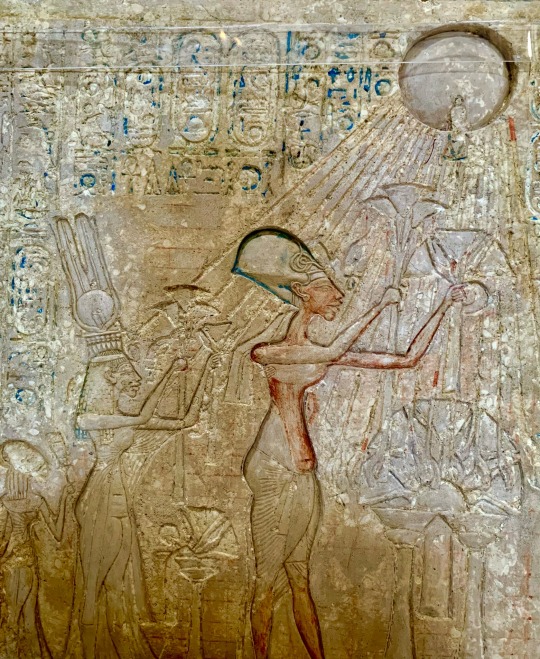
Stela of Akhenaten, showing Akhenaten adoring the Aten with Nefertiti and one of their daughters behind.
2 notes
·
View notes
Text
In 2000+ years, archaeologists will dig up your bones and know nothing about you
I've been reading about Akhenaten. He was a Pharoah of ancient Egypt, and is considered to probably have been Tutankhamun's father.
He changed the polytheistic religion of ancient Egypt to a monotheistic religion (Tutankhamun changed it back) and built a new capital city, Akhetaten, which was abandoned shortly after his death.
After Tutankhamun, the 18th Dynasty ended. The new Dynasty referred to Akhenaten as the "enemy," and "that criminal." His monuments were dismantled, his statues were destroyed, his name was excluded from lists of Egyptian rulers. Was this just because he changed the religion?
Akhenaten was married to Nefertiti, but contemporary art shows him lovingly touching Smenkhkhare. There is speculation Smenkhkare was Akhenaten's brother or son, which doesn't rule out a sexual relationship. With absolutely zero evidence, some Egyptologists decided Akhenaten had two children with his 12 year old daughter.
The "evidence" was the image of a child on her tomb wall, which they decided meant she died in her childbirth, even though no other Egyptian tomb includes a reference to how the person died. And the evidence that the alleged baby (of which there is no evidence) was Akhenaten's is also zero. Seriously, guys, 0 + 0 does not = 4.
There is another theory that the artwork that depicts Smenkhkare and Akhenaten actually depicts Akhenaten and Nefertiti, but Nefertiti is in drag.
Akhenaten possibly had 1, 2, 3, or 4 wives and possibly one of them crossdressed as male or possibly he had a male lover.
A body has been identified as the father of Tutankhamun, but it hasn't been identified as Akhenaten, even though he is recorded as Tutankhamun's father.
A body has been identified as Tutankhamun's mother, but it has not been identified as Nefertiti, even though Nefertiti is recorded as Tutankhamun's mother.
The most interesting thing of it all is that Pharoahs were depicted in art as athletically built men, except for Akhenaten. Akhenaten had a "feminine face, wide hips, and breasts."
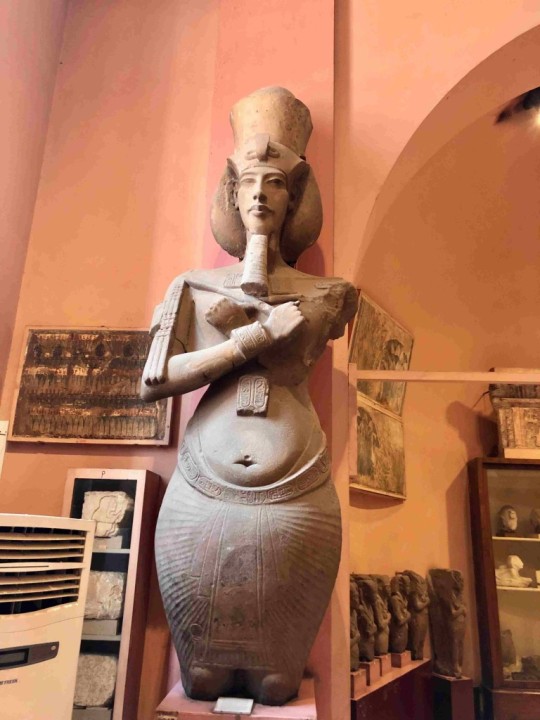


Egyptologists have made many theories about this, including that his "androgynous" (read, female) appearance was caused by Froehlich's syndrome, which would cause a man to have feminine fat distribution. It also causes sterility, and Akhenaten had six kids.
A new theory is that Akhenaten was intersex, which might have been the case.
Or perhaps he was a trans man. He was Pharaoh, his word was law. If his word was that he was a man, who would argue with him? Perhaps the body identified as Tutankhamun's mother is Akhenaten, and the body identified as Tutankhamun's father is Smenkhkhare.
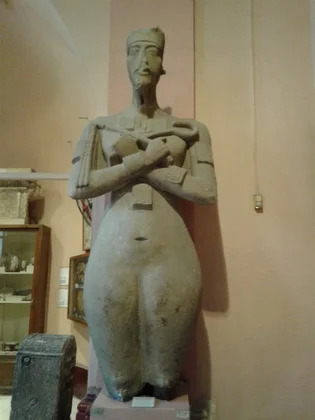
This naked statue of Akhenaten shows him without a penis. And to combat the things his father had done (supposedly, with regards to changing the religion) Tutankhamun was mummified with an erection.
Well, we're not likely to ever know the truth, and that's not really important.
The point of this isn't to say if Akhenaten was trans or intersex or married to a crossdressing queen or one of the first ever recorded gay men in world history, it's to point out that we have no idea.
So if some transphobe is all "when archaeologists dig up your bones, they'll know your sex," you can just remember Akhenaten, and know that archaeology is not as simplistic as bigots would like you to believe.
10 notes
·
View notes
Note
hey. im Ra. well, now im binoy perumbral and i live in west los angeles. culver city to be exact. born in hollywood.
just want to say, Aten was at some point designated Pharoah, and Supreme God of the Universe. the notion that some cat, claiming to be a god, somehow acquiring a female human body, thru some disgusting body modification, is Aten's wife, is because alot of egyptian people are the most vile, ruthless human beings on earth.
Aten is white. He's also known as lil peep. I built a whole city for that white boy. Akhetaten. It devoted 3 years of all of egypts resources and manpower, working overtime, to build that city.
most of the egyptian gods, who are actually egyptian, are not gods, are brown, and there are no such things as brown gods.
why does egyptian history record that Aten's wife is a cat headed girl? umm...because egypt fell apart, and people went crazy, and they try to arrange bad marriages, even though they dont even know this kid, they just dont like him, try to ruin him, destroy his reputation... every record you find on the internet about egyptian history is often modified with complete lies. here is a solar deity list of egypt. these were thee gods of egypt. for 10,000 years. all the other names, i dont know who these people are. and this list i found? theres abou 59% that shouldnt be here. it was just 4. and Aten is in that 4. but he was moved to the future. so noone remembers him. and the other 2 were complete frauds. for reasons i cant get into, they stayed on the list. powered by Apocalypse thru him gifting them divine powers.
Amun, creator deity sometimes identified as a Sun god (not a god, an egyptian military experiment)
Aten, god of the Sun, the visible disc of the Sun (thee God)
Atum, the "finisher of the world" who represents the Sun as it sets (very evil guy, not a God)
Bastet, cat goddess associated with the Sun (its a fucking cat! not a God)
Hathor, mother of Horus and Ra and goddess of the Sun (couldnt turn on a stove, let alone create sunlight, not a God, tolerated, but no more) on top of this, apparently committed abominable acts
Ra (some firecracker, nothing compared to Aten, at best some divine blood) secretly a good looking white guy
Horus (dont know this person, get panic attacks every time I hear hear or see his name)
Khepri, the scarab god, rolling the Sun across the sky (Khepri, literally a scarab, obviously not a sun god, hope he still serves Aten)
i feel i know you. obviously you dont know me. but, you dont like Hathor, i can tell by what you wrote. what did she do to you?
God, enlighten me or eliminate me
Everything else aside, I understand why this is called the "reading comprehension issues" website but on the post I talked about Hathor I compared her to my favorite character bc I loved the parallels I found, and even if you didn't know Mikaela is my favorite character, I literally never wrote anything bad about Hathor?? Why on Earth would you think I don't like her
2 notes
·
View notes
Text
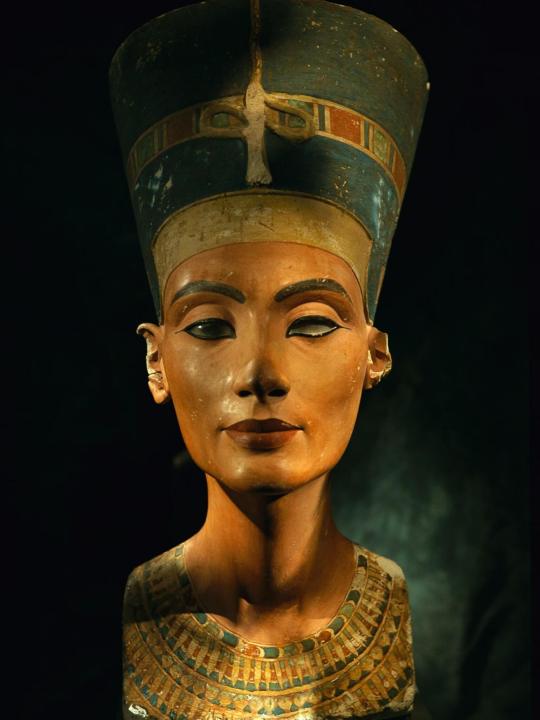
Bust of Queen Nefertiti
New Kingdom, Amarna Period, ca. 1353-1336 BC.
Neues Museum Berlin, Germany. ÄM 21300
The bust, which stands at 48 centimetres (19 in) & weighs 20 kilograms (44 lbs), was discovered on the 6th of December 1912, during an expedition led by Ludwig Borchardt. It was found in remnants the sculptor Thutmose’s workshop in Amarna (ancient city of Akhetaten – Akhenaten’s ill-fated capital), Egypt.
The sculptor Thutmose held the prestigious title of, “The King’s Favourite and Master of Works, the Sculptor Thutmose“.
The estimated date of the statue’s creation is 1345 BC by the sculptor Thutmose during the Amarna Period.
Read more
72 notes
·
View notes
Text
Egyptian scarab of pharaoh Akhenaten with and Udjat eye on the back
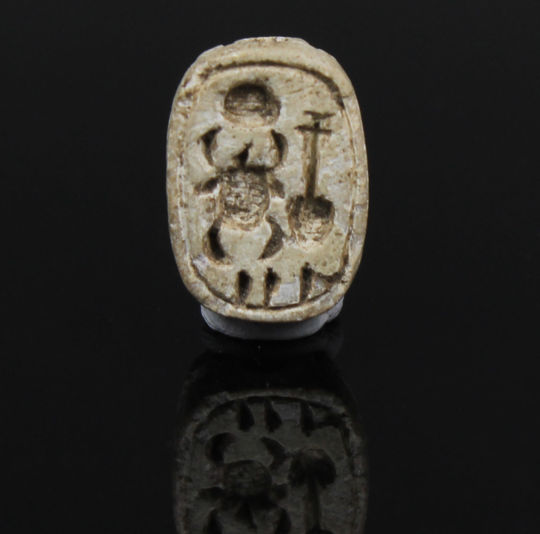
ITEM
Scarab of pharaoh Akhenaten with and Udjat eye on the back
MATERIAL
Steatite
CULTURE
Egyptian
PERIOD
Amarna Period, 14th Century B.C
DIMENSIONS
14 mm x 8 mm
CONDITION
Good condition
PROVENANCE
Ex Museum Exhibiton of the Arbeitsgruppe für Biblische Archäologie, Germany (Deaccession)
Akhenaten, also known as Amenhotep IV, was an ancient Egyptian pharaoh who reigned during the 18th dynasty. He is particularly famous for his radical religious reforms during the Amarna Period (approximately 1353-1336 BCE). Akhenaten introduced a monotheistic religion centered around the worship of the sun disk, Aten, and he moved the Egyptian capital from Thebes to a newly established city called Akhetaten (modern-day Amarna). This period marked a significant departure from the traditional polytheistic beliefs of ancient Egypt. Akhenaten's reign also saw artistic changes, with a more naturalistic style evident in depictions of the royal family. His successor, Tutankhamun, eventually reversed many of these reforms after Akhenaten's death, restoring the old gods and traditions, making the Amarna Period a unique and transformative episode in Egyptian history.
The Udjat Eye, often called the "Eye of Horus" or the "Eye of Ra," is a powerful symbol in ancient Egyptian mythology and is closely associated with protection, healing, and restoration.
Read the full article
#ancient#ancientart#ancienthistory#artefact#artifact#ancientartifacts#antiquities#antiquity#art#artobject#ancientworld#history#classical#archaeology#scarab#udjat#akhenaten#pharaoh#steatite#amarna#egypt#egyptian
0 notes